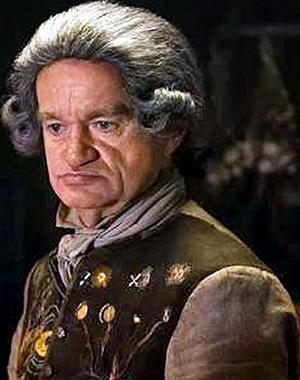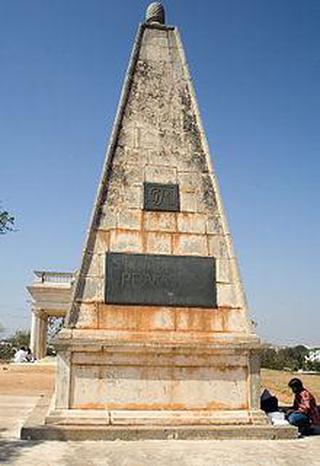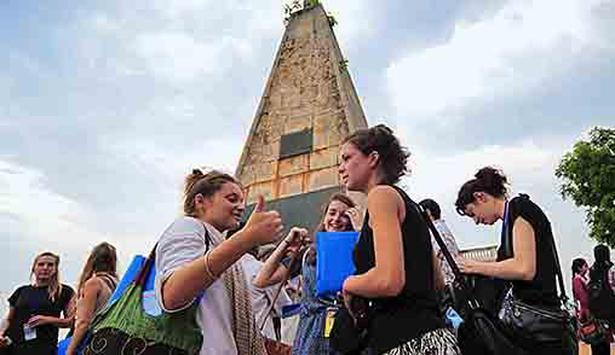source: The Hindu

At a time when the French Revolution was at its peak in France (1789-1790), impacting the entire civilised world with its ideals of Liberty, Equality and Fraternity, there was in Hyderabad an intrepid French General in the service of the second Asif Jah, Nizam Ali Khan, who with his indomitable courage and skills of diplomacy, established a contingent of native army personnel trained on French model that became a strong instrument of warfare to serve the Hyderabad State. The fact that these army men wore headgear similar to the Cap of Liberty, a symbol of the great French Revolution, shows how this French commander wanted to replicate the values of revolutionary France in distant Hyderabad. The guns and cannons he made, after establishing an arsenal and a foundry, became so famous that never in the country, before or after, were such quality ammunition ever made. The indomitable French general behind that contingent was Michel Joachim Marie Raymond, popularly known as Francois Raymond or Monsieur Raymond.
Native regiment
During the last quarter of the 18th century, this enterprising French adventurer, Raymond, came to India as a merchant. But soon he joined as a soldier and served a few native states, before he finally reached Hyderabad to form a native regiment. Here he rose to become its commander and established considerable French influence in the court of the Nizam by winning his trust. Raymond’s passionate commitment to the work he discharged and loyalty to the Nizam were such that his influence on the Nizam continued unabated, till death, even though the British had taken over vast territories of the Circars from the Nizam in 1766 and established their hegemony in Hyderabad court after the eclipse of the French power.

Footprints in history (clockwise) Students at the obelisk, Raymond’s tomb, Monsieur Raymond
Raymond was born in Gascony in France on September 25 , 1755. At the age of 20, in 1775, he came to Pondicherry along with his younger brother, as a merchant. They both wanted to be merchants and even set up a shop. But when Pondicherry fell to the British in 1788, Raymond went to Mysore where he joined the army in the service of Hyder Ali and participated in a number of campaigns against the British. After the death of Hyder Ali in December 1782, Raymond did not like to work under Hyder Ali’s successor. So he moved to Hyderabad and joined the army of Nizam Ali Khan who, as an ally of the British, was opposed to Tipu.
Raymond earned the trust of the Nizam and was appointed as the commander of a contingent of 900. Soon the Nizam increased the number of troops to 14000. Raymond improved the conditions of the Nizam’s army, provided them with modern weapons and trained the men on western lines. The regiment under his command was called ‘the Corps of Francois’ and it became a model army. Raymond was granted a jagir for maintaining his army. Later Raymond was appointed to the post of Controller of Ordinance, Amir-I-Jinsi.

The obelisk on which Joachim Raymond’s initials “ JR” are inscribed
The army commanded by Raymond proved to be a strong instrument of warfare and participated in a number of campaigns with the banner of the French tricolour flag as its motif. He maintained unifirmity in dress, caps and every minute detail of the contingent, on the lines of his native France. The buttons of their dress were engraved with the Cap of Liberty inspired by the ideal of the then ongoing Revolution, back home in his country, France.
Gunfoundry
In order to provide sufficient arms of good quality, Raymond established a gun foundry in 1786, for the manufacture of guns and cannons, the ruins of which still exist in the heart of Hyderabad. The foundry is now a protected monument and the area around it still bears the name, Gunfoundry.
Raymond participated in a number of campaigns for the Nizam during his service. In 1790, he fought against Tipu Sultan of Mysore. Four years later, when the Marathas demanded Chowth from the Nizam, Raymond fought a battle against their army, which incidentally was also commanded by a French general, Perron.
When Mir Ali Jah, the rebel son of the Nizam revolted against the father and occupied the fort of Bidar in 1795, Raymond successfully led the campaign, captured Bidar and brought the recalcitrant prince, a prisoner. For this, Raymond was rewarded by the Nizam with Medak district as a personal jagir.
Raymond suddenly died on 25 March 1798 and his death marked the decline of the French influence in the court of the Nizam. With the signing of the Subsidiary treaty Alliance of Lord Wellesley in 1800, the Nizam had to disband the army that was formed by Raymond.
Recognised and rewarded
Raymond’s performance, talent and character and above all, his loyalty to the Nizam, accorded him an enviable position at the Nizam’s court. Though a foreigner, he became a favourite of Nizam Ali, who treated Raymond as his own son. Adhar-I-Jung (Dragon of Wars), Ajdhar-ud- Daulah (Dragon among Nobles), Mutwar-ul-Mulk (Bravest in the State) were some of the titles the Nizam bestowed on Raymond.
It was not only with the Nizam and the royalty that Raymond was popular. He was very popular among the people — both Hindus as well as Muslims — in Hyderabad. While Muslims called him ‘Musa Rahim’, for Hindus, he was ‘Musa Ram’. An area in the city is also called Moosarambagh.

As GB Malison, the historian pointed out, “No European of mark who preceded him, no European of mark who followed him in India, ever succeeded in gaining to such an extent the love, the esteem and the admiration of the natives of the country”.
Specimens of huge cannons and cannon balls manufactured in the Gunfoundry by Raymond bearing the details of their making, are still seen in places like Public Gardens in Hyderabad. A few are also displayed in the ‘Gun Park’ opposite the Assembly Hall.
Raymond’s Tomb
The tomb of Raymond is made of shining black granite on which an attractive pavilion on a Palladian model with large attractive pillars is built. The entire complex stands on a massive rectangular masonry raised platform. There is also a tall obelisk, on the face of which is a studded black marble tablet inscribed with his name Joachim Raymond, in initials as “J.R” in calligraphic style. The Nizam also ordered for the conduct of annual Urs; at the tomb of Raymond, in March every year, to mark his death anniversary, in which both Hindus and Muslims participated to honour the French hero.
The epitaph on Raymond’s tomb, reflecting the love and affection that Nizam Ali Khan showered on him, reads, “Faithful unto death”. The graves of Raymond’s pet dog and his horse are also seen near his tomb. The entire area around the tomb bears the name Moosaram Bagh in memory of this French General.
Source:http://www.thehindu.com/society/history-and-culture/michel-joachim-marie-raymond-raymonds-tomb/article23936147.ece
" Twitter: #BidarInfo (@BidarInfo) "
At a time when the French Revolution was at its peak in France (1789-1790), impacting the entire civilised world with its ideals of Liberty, Equality and Fraternity, there was in Hyderabad an intrepid French General in the service of the second Asif Jah, Nizam Ali Khan, who with his indomitable courage and skills of diplomacy, established a contingent of native army personnel trained on French model that became a strong instrument of warfare to serve the Hyderabad State. The fact that these army men wore headgear similar to the Cap of Liberty, a symbol of the great French Revolution, shows how this French commander wanted to replicate the values of revolutionary France in distant Hyderabad. The guns and cannons he made, after establishing an arsenal and a foundry, became so famous that never in the country, before or after, were such quality ammunition ever made. The indomitable French general behind that contingent was Michel Joachim Marie Raymond, popularly known as Francois Raymond or Monsieur Raymond.
Native regiment
During the last quarter of the 18th century, this enterprising French adventurer, Raymond, came to India as a merchant. But soon he joined as a soldier and served a few native states, before he finally reached Hyderabad to form a native regiment. Here he rose to become its commander and established considerable French influence in the court of the Nizam by winning his trust. Raymond’s passionate commitment to the work he discharged and loyalty to the Nizam were such that his influence on the Nizam continued unabated, till death, even though the British had taken over vast territories of the Circars from the Nizam in 1766 and established their hegemony in Hyderabad court after the eclipse of the French power.
Footprints in history (clockwise) Students at the obelisk, Raymond’s tomb, Monsieur Raymond
Raymond was born in Gascony in France on September 25 , 1755. At the age of 20, in 1775, he came to Pondicherry along with his younger brother, as a merchant. They both wanted to be merchants and even set up a shop. But when Pondicherry fell to the British in 1788, Raymond went to Mysore where he joined the army in the service of Hyder Ali and participated in a number of campaigns against the British. After the death of Hyder Ali in December 1782, Raymond did not like to work under Hyder Ali’s successor. So he moved to Hyderabad and joined the army of Nizam Ali Khan who, as an ally of the British, was opposed to Tipu.
Raymond earned the trust of the Nizam and was appointed as the commander of a contingent of 900. Soon the Nizam increased the number of troops to 14000. Raymond improved the conditions of the Nizam’s army, provided them with modern weapons and trained the men on western lines. The regiment under his command was called ‘the Corps of Francois’ and it became a model army. Raymond was granted a jagir for maintaining his army. Later Raymond was appointed to the post of Controller of Ordinance, Amir-I-Jinsi.
The obelisk on which Joachim Raymond’s initials “ JR” are inscribed
The army commanded by Raymond proved to be a strong instrument of warfare and participated in a number of campaigns with the banner of the French tricolour flag as its motif. He maintained unifirmity in dress, caps and every minute detail of the contingent, on the lines of his native France. The buttons of their dress were engraved with the Cap of Liberty inspired by the ideal of the then ongoing Revolution, back home in his country, France.
Gunfoundry
In order to provide sufficient arms of good quality, Raymond established a gun foundry in 1786, for the manufacture of guns and cannons, the ruins of which still exist in the heart of Hyderabad. The foundry is now a protected monument and the area around it still bears the name, Gunfoundry.
Raymond participated in a number of campaigns for the Nizam during his service. In 1790, he fought against Tipu Sultan of Mysore. Four years later, when the Marathas demanded Chowth from the Nizam, Raymond fought a battle against their army, which incidentally was also commanded by a French general, Perron.
When Mir Ali Jah, the rebel son of the Nizam revolted against the father and occupied the fort of Bidar in 1795, Raymond successfully led the campaign, captured Bidar and brought the recalcitrant prince, a prisoner. For this, Raymond was rewarded by the Nizam with Medak district as a personal jagir.
Raymond suddenly died on 25 March 1798 and his death marked the decline of the French influence in the court of the Nizam. With the signing of the Subsidiary treaty Alliance of Lord Wellesley in 1800, the Nizam had to disband the army that was formed by Raymond.
Recognised and rewarded
Raymond’s performance, talent and character and above all, his loyalty to the Nizam, accorded him an enviable position at the Nizam’s court. Though a foreigner, he became a favourite of Nizam Ali, who treated Raymond as his own son. Adhar-I-Jung (Dragon of Wars), Ajdhar-ud- Daulah (Dragon among Nobles), Mutwar-ul-Mulk (Bravest in the State) were some of the titles the Nizam bestowed on Raymond.
It was not only with the Nizam and the royalty that Raymond was popular. He was very popular among the people — both Hindus as well as Muslims — in Hyderabad. While Muslims called him ‘Musa Rahim’, for Hindus, he was ‘Musa Ram’. An area in the city is also called Moosarambagh.
As GB Malison, the historian pointed out, “No European of mark who preceded him, no European of mark who followed him in India, ever succeeded in gaining to such an extent the love, the esteem and the admiration of the natives of the country”.
Specimens of huge cannons and cannon balls manufactured in the Gunfoundry by Raymond bearing the details of their making, are still seen in places like Public Gardens in Hyderabad. A few are also displayed in the ‘Gun Park’ opposite the Assembly Hall.
Raymond’s Tomb
The tomb of Raymond is made of shining black granite on which an attractive pavilion on a Palladian model with large attractive pillars is built. The entire complex stands on a massive rectangular masonry raised platform. There is also a tall obelisk, on the face of which is a studded black marble tablet inscribed with his name Joachim Raymond, in initials as “J.R” in calligraphic style. The Nizam also ordered for the conduct of annual Urs; at the tomb of Raymond, in March every year, to mark his death anniversary, in which both Hindus and Muslims participated to honour the French hero.
The epitaph on Raymond’s tomb, reflecting the love and affection that Nizam Ali Khan showered on him, reads, “Faithful unto death”. The graves of Raymond’s pet dog and his horse are also seen near his tomb. The entire area around the tomb bears the name Moosaram Bagh in memory of this French General.
Source:http://www.thehindu.com/society/history-and-culture/michel-joachim-marie-raymond-raymonds-tomb/article23936147.ece
" Twitter: #BidarInfo (@BidarInfo) "

No comments:
Post a Comment